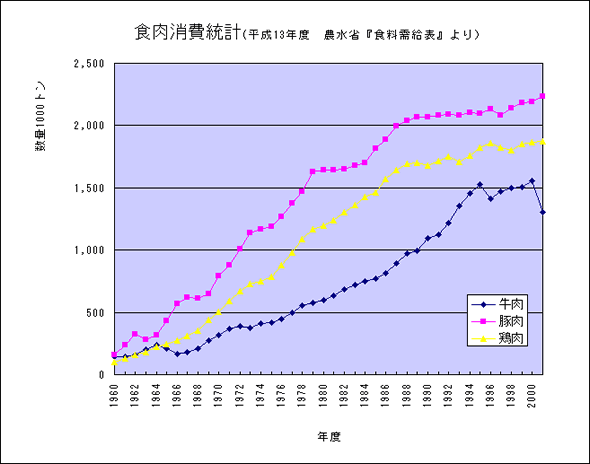 |
   |
| HOME > Animal Factory > Factory Farming in Japan |
|
|
|||||||||
ALIVE
All Life In a Viable Environment
5-18-10-102, Honkomagome, Bunkyo-ku, Tokyo, 113-0021
Japan
Tel.+81-3-5978-6272
Fax..+81-3-5978-6273
![]()
Anti Vivisection Action Network
|
Factory Farming in JapanFusako Nogami (ALIVE)
For over a thousand years, agriculture in Japan was synonymous
with rice cultivation in paddy fields. An edict prohibiting
animal slaughter based on Buddhist teaching was issued frequently
in pre-modern Japan. Due to these factors, farm animals in Japan
were traditionally kept only for work in the field and not for
meat. The unprecedented economic
growth during the 1950ís
and 1960ís however, profoundly
changed farming in Japan
by introducing large-scale
farming with modern agriculture
machines. From the 1960ís
onwards, the meat consumption
increased greatly and the
figure in 2000 increased
by five-fold. This is a
result of the Japanese
governmentís policy in
which large scale modern
farming was promoted
by granting generous
government
funding.
 As a consequence of factory
farming, as it is know
today, there have been
a number of outbreaks of
various infectious animal
diseases in recent years.
Some of the serious examples
are:
In 1996, food poisoning
caused by O-157 killed
12 people and over ten
thousand people were affected.
There have been similar
cases since then throughout
the country in which several
people died and thousands
were affected.
In 1996, The first cow
to be infected by BSC was
discovered. Since then
11 cases have been identified.
In 2000, for the first
time in 92 years Foot and
Mouth disease was discovered
in Miyazaki and Hokkaido
(the southern and northern
tips of Japan) and 22 infected
and 718 suspected animals
were destroyed.
In 2000, serious food
poisoning broke out at
Yukijirushi, the largest
dairy food manufacturer
in Japan.
In 2003, formalin, a prohibited
substance, was discovered
in farmed blowfish (more
than 60% of the growers
were found to be using
the substance).
In January 2004, bird
flu broke out. In late
February, infected birds
were found in a large poultry
farm where its entire stock
of 250,000 birds were destroyed.
These outbreaks of diseases
have lead to the overuse
of chemicals on animals.
In particular, the amount
of antibiotics used on
stock is extremely high.
It is estimated that in
Japan, antibiotics in medical
use is 500 tons (100 tons
used in hospital and 400
tons as prescription) but
the use on stock is as
much as 1200 tons (900
tons on poultry, pigs and
cows, 200 tons on farmed
fish and 100 tons on vegetable,
fruits and rice). This
has resulted in breeding
a strain of bacteria that
are resistant to antibiotics,
and it is estimated that
20,000 deaths are caused
by these antibiotic-resistant
bacteria every year.
The high consumption
of animal fat and protein
have lead to an increase
in chronic diseases, of
which cancer, heart diseases
and stroke are the top
three causes of death in
Japan today
Japan grows only 40%
of its food (calorie supply).
Meat products in particular
are heavily dependent on
import, and only 25% of
animal feed is grown in
the country.?90% of feed
for 1.7 million dairy animals,
2.8 million beef cattle,
9.7 million pigs and 300
million chickens that are
grown in Japan is imported.
A large amount of grain
import by one country causes
unequal distribution of
food in the world. Moreover,
this intensive factory
farming is well beyond
the capacity of existing
facilities for animal waste
disposal, which is causing
very serious environmental
problems.
|
| |